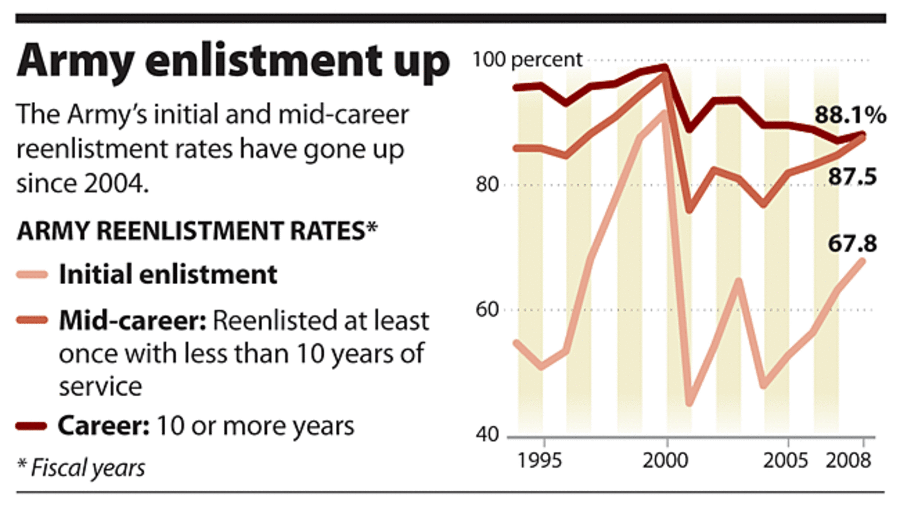Will improved military enlistment last?
Loading...
| Washington
The US military is maintaining its allure during the economic downturn as thousands of service members are opting to stay in the service.
But a number of factors converging this year may complicate the military's ability to retain them over the next couple years.
The Pentagon is preparing to implement a comprehensive new GI Bill to subsidize service members who want to attend college. The bill, which goes into effect in August, is considered as a way to pay back a generation of troops who have made enormous sacrifices in Iraq and Afghanistan with a generous package of school benefits.
But, depending on a number of factors, including the economy, the new school benefits could induce many service members to leave the service this year to go to school on the government's dime. At the same time, the services may have to cut back on the lavish pay-to-stay retention budgets that have kept them attractive.
All this spells uncertainty for the health of the military in the next year or so.
"It's tricky. It really depends on which of these factors wins out," says Anita Hattiangadi, a senior analyst at CNA, a think tank that does work for the military.
The "Post 9/11 GI Bill" is the first significant expansion of the benefit since the first GI Bill was created in 1944. The new bill was passed last year despite disagreement between lawmakers and the Pentagon. Although both wanted to reward troops with expanded school benefits, defense officials were also concerned that an overly generous package would hurt retention.
The bill provides full room and board, tuition fees equivalent to an in-state college or university and an annual stipend of $1,000. Rent assistance would cover the equivalent of a two-bedroom townhouse.
A "transferability" option was added to allow troops to pass the benefit on to family members, in the hope that this would minimize the number of service members leaving for college.
However, there is still a large contingent of service members who have no spouse or children to transfer the benefit to, and who might choose to leave. [Editor's note: The original version didn't specify clearly to whom the benefit could be transferred.]
The Marine Corps, for example, which employs a generally younger demographic, could see a small exodus. "We've suddenly created a very interesting option," acknowledges Bill Carr, deputy under secretary for military personnel policy at the Pentagon. Internal defense surveys suggest there won't be a stampede out the door. "But we don't know."
"This is a genuine issue," agrees Cindy Williams, principal research scientist in security studies at MIT in Boston. "The new GI Bill, when it kicks in in August, is certainly going to attract some service members to leave because it is extremely generous."
At the same time, the Marine Corps and the Army's enormous retention budgets, which pay service members to stay and have been expanding for years, may be trimmed as part of defense budget cuts.
The Marine Corps' annual retention budget is about $470 million, up nearly 10 times from five years ago. The Army is spending more than $665 million to keep soldiers, up from $35 million in 2003 when the war in Iraq began. These bonuses have helped the Army and Marine Corps, which are most heavily engaged in the wars, exceed their retention rate targets for the last several years.
Yet, in rewarding the sacrifices of those who are serving, the military has created a generation of service members used to regular bonuses for reenlisting – as much as $150,000 in some fields – and it may be hard to wean them off.
There are other factors. Military planners are beginning to envision what a "postwar" environment will look like and how the military would make the transition as war operations are likely to abate over the next few years.
Many in the military will welcome the respite from back-to-back deployments, some lasting as long as 15 months. But deployments – with the constant training and plentiful equipment they entail – have their own role in keeping retention rates strong in the military.
After years of massive defense budgets, the economy and slowing down of war operations may force big cuts in defense spending habits. If this translates into significantly reduced training and infrastructure, the military may suffer particularly in retaining service members.
Officials say they can maintain strong retention rates if they keep service members engaged after they come home. "Management of work tempo is important," says the Pentagon's Mr. Carr. "If that were to crash too sharply, say for a lack of paid-for flight hours or tank miles, it can create its own retention problems."
One solution is to create a "controlled descent" as the military transitions to what may be a new, less busy phase, says Carr.
"A recipe for readiness and retention? In a word, balance."






